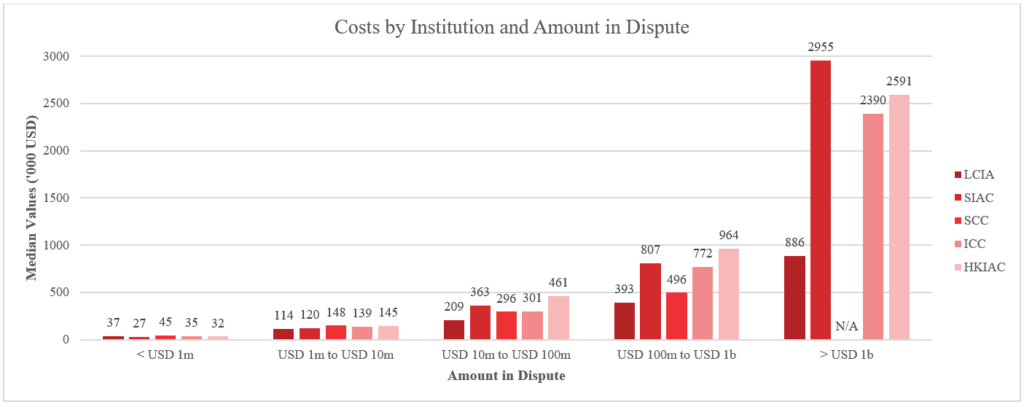Introduction
On 30 December 2024, the London Court of International Arbitration (“LCIA”) published its third costs and duration analysis (the “2024 Report”), covering all cases which reached a final award between 1 January 2017 and 12 May 2024. This builds on its previous report, Facts and Figures – Costs and Duration: 2013-2016, published in October 2017 (the “2017 Report” and together with the 2024 Report the “Reports”). The 2024 Report covers a longer time period than any costs and duration analysis completed by any other institution.
In summary, the 2024 Report concludes that the median duration of LCIA cases was 20 months, a slight increase from the median reported in the 2017 Report. Regarding costs, the median costs for the cases analysed in the 2024 Report were USD 117,653, increased from USD 97,000 in the 2017 Report. Despite this increase, LCIA arbitration appears to remain a more cost-effective option than several of the other major arbitral institutions, especially for cases with high claim values.
Between 1 January 2017 and 12 May 2024, 1,625 awards were issued by LCIA tribunals. For the purposes of the 2024 Report, only cases that reached a final award in the relevant time period were included. For the avoidance of doubt, any cases which were settled, or concluded before determination of substantive issues, were excluded – the total number of cases analysed was 616. Of these 616 cases, 568 had a quantified amount in dispute, and 48 were unquantified. The 2024 Report noted that the number of cases from year to year has trended upwards.
Duration
The LCIA measured both total duration (defined as the time from the LCIA’s receipt of the Request for Arbitration and final award) as well as time to award (defined as the time between the parties’ final submissions on the merits of the dispute and the final award) for the purposes of the Reports.

The median duration across all cases analysed for the 2024 Report was 20 months, up from a 16-month median in the 2017 Report. The median time to award across all cases analysed for the 2024 Report was 4 months, up from a 3-month median in the 2017 Report. Several trends were consistent between both of the Reports. For example, both Reports showed a clear correlation between increased amount in dispute and increased duration. By contract, however, in both Reports, the time to award remained largely consistent across amounts in dispute, meaning that arbitrators tended not to require additional time to decide when larger amounts of money were in dispute.
Interestingly, the 2024 Report notes that Article 15.10 of the LCIA Rules 2020 states that tribunals will aim to reach award within three months of final submissions, and concludes that “this report confirms that arbitrators are reaching close to this target, with the average time to award being four months.” While it is true that the median time to award reported was four months, the 2024 Report separately states that nearly half of all cases resulted in an award in under four months. It follows, therefore, that over half of all cases took longer than four months to reach final award, casting doubt on the strength of the claim that “arbitrators are reaching close to this target.”
The 2024 Report also analysed the impact of COVID-19 on the duration of cases. While a comprehensive analysis is not yet possible, as some cases commenced towards the end of the pandemic remain ongoing, the initial analysis suggests an increase in case duration post-March 2020. However, the report notes that this increase may not be as substantial as expected, potentially due to the fact that the ability to hold virtual hearings allowed for certain cases to be expedited.
Costs
For the purposes of the Reports, arbitration costs are the sum of tribunal fees and LCIA administrative charges. Tribunal fees include the hourly rates charged by arbitrators, cancellation fees, fees for issuing a memorandum of correction, and the hourly rates charged by a tribunal secretary (if appointed). LCIA administrative fees include the registration fee, hourly charges of the LCIA secretariat, and a fee of 5% of the total tribunal fees.The median LCIA arbitration costs for the 2024 Report were USD 117,653, increased from USD 97,000 in the 2017 Report (though not adjusted for inflation, so the difference is smaller in reality). An increase in costs can also be seen in the final years analysed for the 2024 Report. On that point, the LCIA pointed to the fact that cases awarded in the past two years have had larger claim values as well as longer durations, which is consistent with higher costs.

As would be expected due to the LCIA’s hourly rates, cases with longer durations (potentially due to increased complexity) had higher costs. According to the 2024 Report, all cases with a duration of under six months, and nearly 70% of cases with durations between 7-12 months, cost under USD 50,000. In contrast, over 50% of cases which lasted longer than two years had arbitration costs above USD 300,000.
Cost Comparison Between Institutions
The 2024 Report compares LCIA arbitration costs against arbitration costs from the International Chamber of Commerce International Court of Arbitration (“ICC”), Singapore International Arbitration Centre (“SIAC”), Stockholm Chamber of Commerce Arbitration Institute (“SCC”), and the Hong Kong International Arbitration Centre (“HKIAC”) (together, the “other institutions”). For the purposes of the 2024 Report, the LCIA used available information on the other institutions’ cases to estimate arbitration costs using the cost calculators embedded on the other institutions’ websites. The 2024 Report acknowledges that these estimates may not be wholly accurate, as certain information in respect the other institutions was unavailable, and that the schedules of costs provided by the other institutions provide a range or maximum amount, rather than an exact cost.

The data in the chart above shows that, across almost all amounts in dispute, the LCIA has the lowest median arbitration costs. As amounts in dispute increase, the difference between the institutions becomes starker. For disputes valued at USD 100 million to USD 1 billion and above, the LCIA’s costs are less than half of the costs of the SIAC and HKIAC, and close to half of the costs of the ICC. This is likely attributable in large part due to the fact that the LCIA uses an hourly rate system, while the other institutions primarily calculate costs based on the amount in dispute. The exception is the HKIAC, which lets parties choose between the hourly and value-based systems. In the other institutions, a relatively simple claim in respect of a significant contract would be likely to attract a large cost. However, in the LCIA, its simplicity would likely lead to a reduction in tribunal hours required leading to a lower charge.
Conclusion
The 2024 Report provides useful insight into the potential costs and efficiency of LCIA arbitration for those who may be considering the LCIA as an arbitration venue and comparing it against other institutions. It highlights the potential benefits of the hourly rate cost structure, showing that the LCIA may be worth considering for simple claims, or claims of particularly high value.







